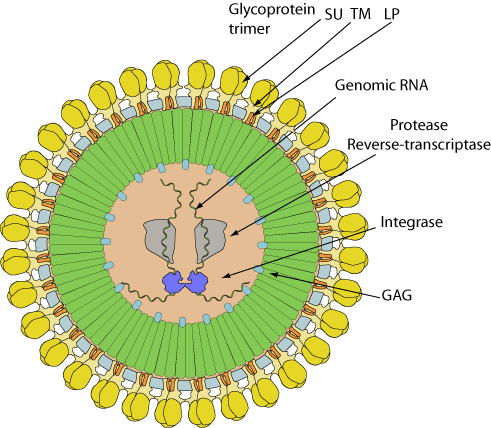Bovispumavirus (taxid:2169664)

Enveloped viruses, spherical to pleomorphic in shape, measuring approximately 80?100 nm in diameter. Their structural proteins assemble into an icosahedral capsid with T=13 dextro symmetry .
Notably, about 20% of released viral particles already contain double-stranded DNA genomes. This reflects a unique feature of spumaviruses, in which reverse transcription of the genomic RNA begins before viral release, rather than after entry into a new host cell, as observed in other retroviruses.
GENOME
Monopartite, linear, dimeric, ssRNA(+)/dsDNA (depending on the timing of reverse transcription) genome of about 12 kb, with a 5'-cap and a 3'poly-A tail. There are two long terminal repeats (LTRs) of about 600nt long at the 5' and 3' ends. The LTRs contain the U3, R, and U5 regions. There are also a primer binding site (PBS) at the 5'end and a polypurine tract (PPT) at the 3'end.
GENE EXPRESSION
The integrated provirus utilizes the promoter elements in the 5'LTR to drive transcription. This gives rise to the unspliced full length mRNA that will serve as genomic RNA to be packaged into virions or used as a template for translation of gag (Gag protein, p3).
The spliced mRNAs encode (pro)pol (PR, RT, RnaseH, IN) and env (Leader peptide, SU, TM). Incompletely spliced mRNAs contain cis-acting sequences that directly bind cellular factors to allow export from the nucleus into the cytoplasm.
The genome encodes for two additional ORFs encoding bel,and tas that are expressed predominantly by the internal promoter (IP) localized in the env gene.
ENZYMES
- Reverse transcriptase
- RNAse H [RT]
- Polyprotein protease (Peptidase A9) [PRO]
- Integrase [INT]
REPLICATION
- Virus attaches to host receptors through the SU glycoprotein. TM glycoprotein mediates fusion with cell membrane.
- Internalization and uncoating.
- ssRNA(+) or dsDNA genome enter the cell. ssRNA is copied into a linear dsDNA molecule by the reverse transcriptase.
- Nuclear entry of the viral dsDNA which is covalently and randomly integrated into the cell's genome by the viral integrase (=provirus).
- Transcription of provirus to form viral RNAs and splicing.
- Translation of the RNAs to form precursor polyproteins.
- Late reverse transcription can occur.
- Assembly of the virion and packaging of the viral RNA genome.
- Budding predominantly into the endoplasmic reticulum (ER) and occasionally through the plasma membrane, most viral particles remain in the cell.
- Proteolytic processing of the precursors polyproteins by viral protease and maturation of the virions.
